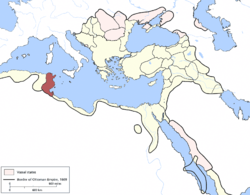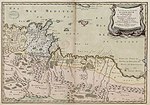
Back إيالة تونس Arabic Túnez otomanu AST Osmanlı Tunisi Azerbaijani উসমানীয় তিউনিসিয়া Bengali/Bangla Osmanské Tunisko Czech Εγιαλέτι της Τύνιδας Greek Túnez otomano Spanish ایالت تونس Persian Tunisie ottomane French תוניסיה העות'מאנית HE
This article possibly contains original research. Information in some parts may not match the cited sources. (May 2023) |
Eyalet of Tunis | |||||||||
|---|---|---|---|---|---|---|---|---|---|
| 1574–1881 | |||||||||
 The Eyalet of Tunis in 1609 | |||||||||
| Status | Eyalet of the Ottoman Empire | ||||||||
| Capital | Tunis | ||||||||
| Common languages | Tunisian Arabic, Ottoman Turkish, Judeo-Tunisian Arabic, Berber | ||||||||
| Religion | Sunni Islam | ||||||||
| Government | Monarchy | ||||||||
| History | |||||||||
| 13 September 1574 | |||||||||
• Janissary Deys rise to power | 1591 | ||||||||
• Muradid dynasty begins | 1613 | ||||||||
• Husainid dynasty begins | 1705 | ||||||||
• French protectorate established | 12 May 1881 | ||||||||
| Currency | Tunisian rial | ||||||||
| |||||||||
| Today part of | Tunisia Algeria | ||||||||
| History of Tunisia |
|---|
 |
|
|
Ottoman Tunisia, also known as the Regency of Tunis,[1][2][3] refers to the Ottoman presence in Ifriqiya from the 16th to 19th centuries, when Tunis was officially integrated into the Ottoman Empire as the Eyalet of Tunis. The Ottoman presence in the Maghreb began with the takeover of Algiers in 1516 by the Ottoman Turkish corsair and beylerbey Aruj (Oruç Reis), eventually expanding across the entire region except for Morocco. The first Ottoman conquest of Tunis occurred in 1534 under the command of Khayr al-Din Barbarossa, the younger brother of Aruj, who was the Kapudan Pasha of the Ottoman Fleet during the reign of Suleiman the Magnificent. However, it was not until the final Ottoman reconquest of Tunis from Spain in 1574 that the Turks permanently acquired the former territories of Hafsid Tunisia, retaining it until the French occupation of Tunisia in 1881.
Tunis was initially under Ottoman rule from Algiers, but the Ottoman Porte soon directly appointed a governor (pasha) supported by janissary forces. However, Tunisia quickly gained autonomy and operated as an autonomous province under the local bey, also referred to as the Beylik of Tunis. While Algiers occasionally contested this autonomy, Tunisia successfully maintained its status. Throughout this period, the governing councils in Tunisia were composed mainly of foreign elite, conducting state affairs primarily in the Ottoman Turkish language.
Barbary pirates targeted European shipping, primarily originating from Algiers, Tunis, and Tripoli. However, after a prolonged period of diminishing raids, the increasing power of European states eventually brought an end to the practice through the Barbary Wars. During the Ottoman Empire's rule, Tunisia experienced territorial contraction, losing land to the west (Constantine) and the east (Tripoli). In the 19th century, Tunisian rulers took note of the ongoing political and social reforms in the Ottoman capital. Inspired by these reforms and the Turkish model, the Bey of Tunis embarked on modernizing institutional and economic reforms. However, Tunisia's mounting international debt provided a reason or pretext for French forces to establish a Protectorate in 1881.
A legacy of centuries of Turkish rule is the existence of a Turkish-origin population. Historically, male descendants were known as the Kouloughlis.
- ^ Abadi, Jacob (2013). Tunisia Since the Arab Conquest: The Saga of a Westernized Muslim State. Ithaca Press. ISBN 978-0-86372-435-0.
- ^ Moalla, Asma (2005). The Regency of Tunis and the Ottoman Porte, 1777-1814: Army and Government of a North-African Eyâlet at the End of the Eighteenth Century. RoutledgeCurzon. ISBN 978-1-134-42983-7.
- ^ Blili, Leïla Temime (2021). The Regency of Tunis, 1535–1666: Genesis of an Ottoman Province in the Maghreb. American University in Cairo Press. ISBN 978-1-64903-049-8.
© MMXXIII Rich X Search. We shall prevail. All rights reserved. Rich X Search

